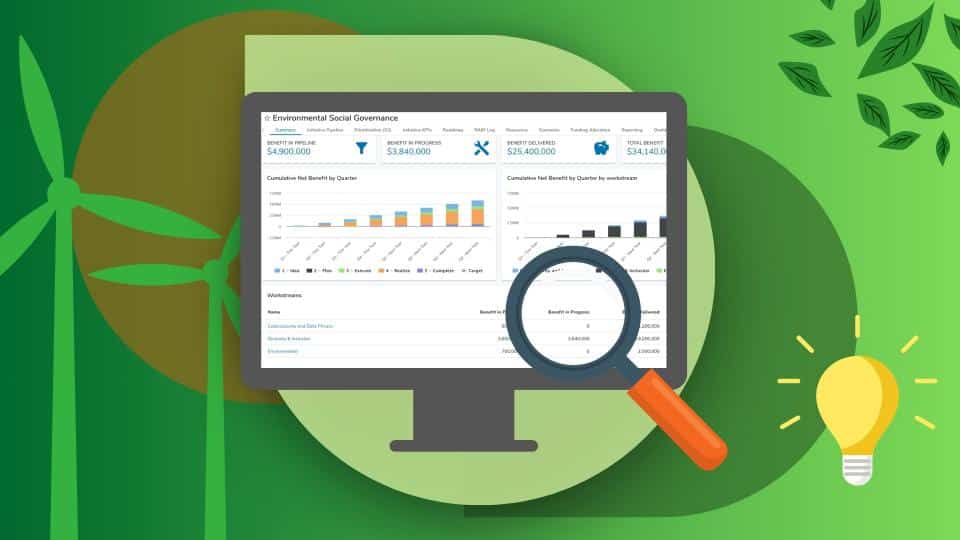Environmental, social, and governance (ESG) is no longer a buzzword. It’s become a major strategic component of virtually every leading corporation’s strategy. The focus on ESG is well-placed, as a company’s approach to ESG can impact everything from its reputation to employee retention and stock prices.
Investors and lenders are paying close attention to how companies are disclosing and addressing sustainability, privacy, cybersecurity, and other ESG risks. In fact, 86% of institutional investors said that assessing companies’ ESG risk posture is a part of their fiduciary duty, and 90% expect companies with leading ESG practices to deliver better returns over a 12-month period.
But figuring out what to measure and disclose can be challenging, especially since greenwashing (conveying a false or misleading sense of sustainability) has been common practice. Even the best-intentioned companies can struggle to select the right metrics to demonstrate their progress and the business impact of their ESG initiatives. To create a better future for themselves, their shareholders and the planet, companies need to find meaningful measures to gauge progress of their ESG initiatives and their impact.
Why is Measuring ESG Impact Difficult?
There are a variety of challenges that come with putting numbers into ESG and sustainability efforts.
One major hurdle is getting accurate baseline data needed to set informed targets. Before a company launches new ESG initiatives to improve particular domains (e.g., carbon footprint, water consumption, promotion rate of people of color within the organization), it needs to know how it has done in the past. Yet, companies may not even have been tracking or collecting this data.
According to EY, there’s a lack of available ESG data for many industries. While some data is easy to collect, other data sources (e.g., total carbon emissions of the company) can be very hard to measure accurately because the total includes the carbon emissions of a company’s suppliers.
Unfortunately, companies often don’t have a strong gauge of how their key suppliers are contributing to their overall impact. Sectors like financial services, real estate, and oil and gas have high scope 3 carbon emissions. If a company in one of these sectors wants to make a serious effort to reduce their own emissions, they must first understand their suppliers’ emissions level and may have to switch to greener suppliers.
Further, evolving regulations and climate change policies also affect what companies need to report, which can be difficult if companies aren’t collecting that particular type of data. Even deciding which metrics to use to track ESG initiatives can be controversial.
Tips and Tools for Collecting Data and Measuring ESG Impact

Organizations have many tools at their disposal for assessing their ESG impact. The specific ones to choose should be based on your organizational circumstances. Here are some questions to guide your process to select the appropriate data points and key performance indicators to track:
- What current legal and regulatory requirements could affect how you gather data around these activities? For instance, do you need to use a particular disclosure/reporting framework such as SASB Standards or the framework developed by the Task Force on Climate-Related Financial Disclosures (TCFD)?
- Are there industry standard benchmarks that can help you set reasonable goals? A great example is the S&P ESG Industry Report Card for the oil and gas industry.
- What public data exists to inform your benchmarks? If you want a rough idea of a benchmark, the government sometimes offers public data, such as data on water consumption and pollution levels.
Once you’ve baselined your ESG impact and know which KPIs to track and report, you can start to look for tools that simplify and streamline the work that needs to be done to get the right data and turn them into regulator-ready reports. Here are few types of tools to consider:
- Automated data collection and management tools that ease the collection and reporting of consumption and/or emissions data (e.g. carbon emissions, water consumption, waste, etc.)
- Audit compliance and reporting tools that help you govern processes around data collection, report sign-off and collect compliance artefacts. These software tools usually contain out-of-the-box reporting templates (e.g. SASB standards) to help users build disclosures in a format that meets regulators’ requirements
- Strategic initiative/program management tools that help manage the entire lifecycle of ESG initiatives from ideation to benefit realization
- Open-source tools, guides and data benchmarks from non-profit organizations such as Ceres and companies who are leaders in corporate social responsibility
How to Set SMART Goals for an ESG Program
While you may be tempted to set highly lofty goals, that’s not the best strategy if you want people to support the program enthusiastically. To set appropriate goals for your sustainability or ESG program, keep these considerations in mind:
- Align your goals and metrics with standards published by authoritative organizations, and large-scale public initiatives (i.e., the EPA, International Sustainability Standards Board, Science Based Targets initiative, etc.). Doing so will lend credibility to your efforts and provide you with solid benchmarks.
- Like any goals, ESG goals should be SMART (Specific, Measurable, Achievable, Relevant, and Time-Bound).
- Select ESG goals and launch initiatives which are highly aligned with your business strategy. Make sure that your goals are relevant for your industry’s material risks, streamlines your operations and advancing the interest of your key stakeholder groups.
- Start small. You don’t have to save the whole planet at once. It’s better to set small achievable goals rather than to greenwash and overpromise, which can erode trust in your ESG program.
As you set ESG goals, remember that you don’t have to do everything alone. There are many agencies, consultants, and tools there to help you progress. You can modify your goals as you gather data and feedback. Using data to gauge progress and learning from your mistakes are vital.
Manage ESG Initiatives with Rigor

To succeed, treat your ESG program like you would any strategic program in the business: get input from a variety of stakeholders, assign responsibility to individuals, check in on results on a regular basis, seek incremental improvements, and adjust resource allocation and execution tactics based on what you’ve learned.
Unfortunately, many organizations fall short, especially in two realms: Keeping ESG initiatives on track during the execution phase and understanding ESG initiatives’ impact on the business (e.g. cost-savings, operational efficiency gains, customers retained, etc.).
Many ESG programs are still managed in a collection of spreadsheets, slide decks, and emails. As a result, decision-makers have trouble finding timely and relevant data to identify whether certain projects and initiatives are off-track. They don’t get the chance to course-correct in time, by adjusting goals and expectations or resource allocation across projects. This ultimately hampers the value of ESG programs. A second consequence of this approach is that benefits data is too hard to pull together to gauge business impact of initiatives.
To remedy these issues, we recommend organizations use an initiative management approach and software that centralizes management of all phases of ESG initiatives and projects.
The Future of ESG
Technological advancements will continue to make ESG data collection, reporting and initiative management easier. In particular, artificial intelligence and machine learning (AI/ML) will likely play a meaningful role, especially as AI can enhance ESG through climate change modeling, compliance, and fighting discrimination.
Politics and social change will also likely become more deeply tied to ESG. Laws and regulations will be updated frequently. The Corporate Governance Institute predicts that companies that don’t take an ESG stand will suffer in terms of their finances and reputation.
Last but not least, we expect to see more cross-sector collaboration going forward, with company leaders, academic scientists and policy-makers convening to discuss best practices, share research, and innovate together.
How Shibumi Can Boost Your ESG Efforts
Here at Shibumi, we’ve built strategic program management software to help organizations plan, govern and execute strategic initiatives and measure these initiatives’ ROI. Our data-focused platform allows you to set high-level objectives or corporate goals, break those down into smaller initiatives and projects, allocate funding, manage initiatives’ execution and measure the benefits they deliver to your organization, customers, investors and the environment. Request a demo to see how our software can help you accelerate your ESG efforts.

